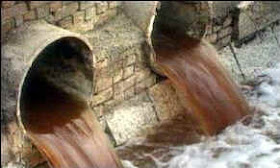
Good Water Quality Physical Parameters
WHAT ARE THE PHYSICAL PARAMETERS OF GOOD WATER QUALITY?
The physical parameters of water quality can be broken down into many topics such as turbidity and taste or odor to name a few.
 But one needs to also take into consideration the nature of the physical parameters of the ecosystem surrounding a water source to also understand the physical appearance of a later finished water.
But one needs to also take into consideration the nature of the physical parameters of the ecosystem surrounding a water source to also understand the physical appearance of a later finished water.
One of the best barometers of a water is its actual temperature in its natural ecosystem.
Temperature affects sediment and microbial growth among other source water characteristics.
What are the variables that affect a waterway's temperature?
 1. The color of the water. Most heat warming surface waters comes from the sun, so waterways with dark-colored water, or those with dark muddy bottoms, absorb heat best.
1. The color of the water. Most heat warming surface waters comes from the sun, so waterways with dark-colored water, or those with dark muddy bottoms, absorb heat best.
2. The depth of the water. Deep waters usually are colder than shallow waters simply because they require more time to warm up.
3. The amount of shade received from shoreline vegetation. Trees overhanging a lake shore or river bank shade the water from sunlight.
Some narrow creeks and streams are almost completely covered with overhanging vegetation during certain times of the year.
The shade prevents water temperatures from rising too fast on bright sunny days.
4. The latitude of the waterway. Lakes and rivers in cold climates are naturally colder than those in warm climates.
5. The time of year. The temperature of waterways varies with the seasons.
 6. The temperature of the water supplying the waterways. Some lakes and rivers are fed by cold mountain streams or underground springs.
6. The temperature of the water supplying the waterways. Some lakes and rivers are fed by cold mountain streams or underground springs.
Others are supplied by rain and/or surface run-off. The temperature of the water flowing into a lake, river or stream helps determine its temperature.
7. The volume of the water. the more water there is, the longer it takes to heat up or cool down.
8. The temperature of effluents dumped into the water. When people dump heated effluents into waterways, the effluents raise the temperature of the water.
Fish and most aquatic organisms are cold-blooded.
 9. Consequently, their metabolism increases as the water warms and decreases as it cools. Each species of aquatic organism has its own optimum (best) water temperature.
9. Consequently, their metabolism increases as the water warms and decreases as it cools. Each species of aquatic organism has its own optimum (best) water temperature.
If the water temperature shifts too far from the optimum, the organism suffers. Cold-blooded animals can't survive temperatures below 0 C (32 F), and only rough fish like carp can tolerate temperatures much warmer than about 36 oC (97 F).
Fish can regulate their environment somewhat by swimming into water where temperatures are close to their requirements.
Fish usually are attracted to warm water during the fall, winter and spring and to cool water in the summer.
10. Did you ever notice how fish swim down to the cooler parts of the lake to escape the heat of the noonday sun?
Fish can sense very slight temperature differences. When temperatures exceed what they prefer by 1-3 C, they move elsewhere!
Fish migration often is linked to water temperature.
11. In early spring, rising water temperatures may cue fish to migrate to a new location or to begin their spawning runs.
The autumn drop in temperature spurs baby marine fish and shrimp to move from their nursery grounds in the estuaries out into the ocean, or into rivers, as the case may be.
12. As you can see, all sorts of physiological changes take place in aquatic organisms when water temperatures change.
The American Public Health Association (APHA) defines turbidity as "the optical property of a water sample that causes light to be scattered and absorbed rather than transmitted in straight lines through the sample."
In simple terms, turbidity answers the question, "How cloudy is the water?"
Light's ability to pass through water depends on how much suspended material is present.
13. Turbidity may be caused when light is blocked by large amounts of silt, microorganisms, plant fibers, sawdust, wood ashes, chemicals and coal dust.
Any substance that makes water cloudy will cause turbidity. The most frequent causes of turbidity in lakes and rivers are plankton and soil erosion from logging, mining, and dredging operations.
RELATED POSTS:
.
CLICK HERE . . .
.
CLICK HERE . . .
.
CLICK HERE . . .
.
PURICARE
INDUSTRIAL
ENTERPRISES
Water
Treatment
Systems
.
...
CLICK HERE . . . to view company profile . . .










No comments:
Post a Comment